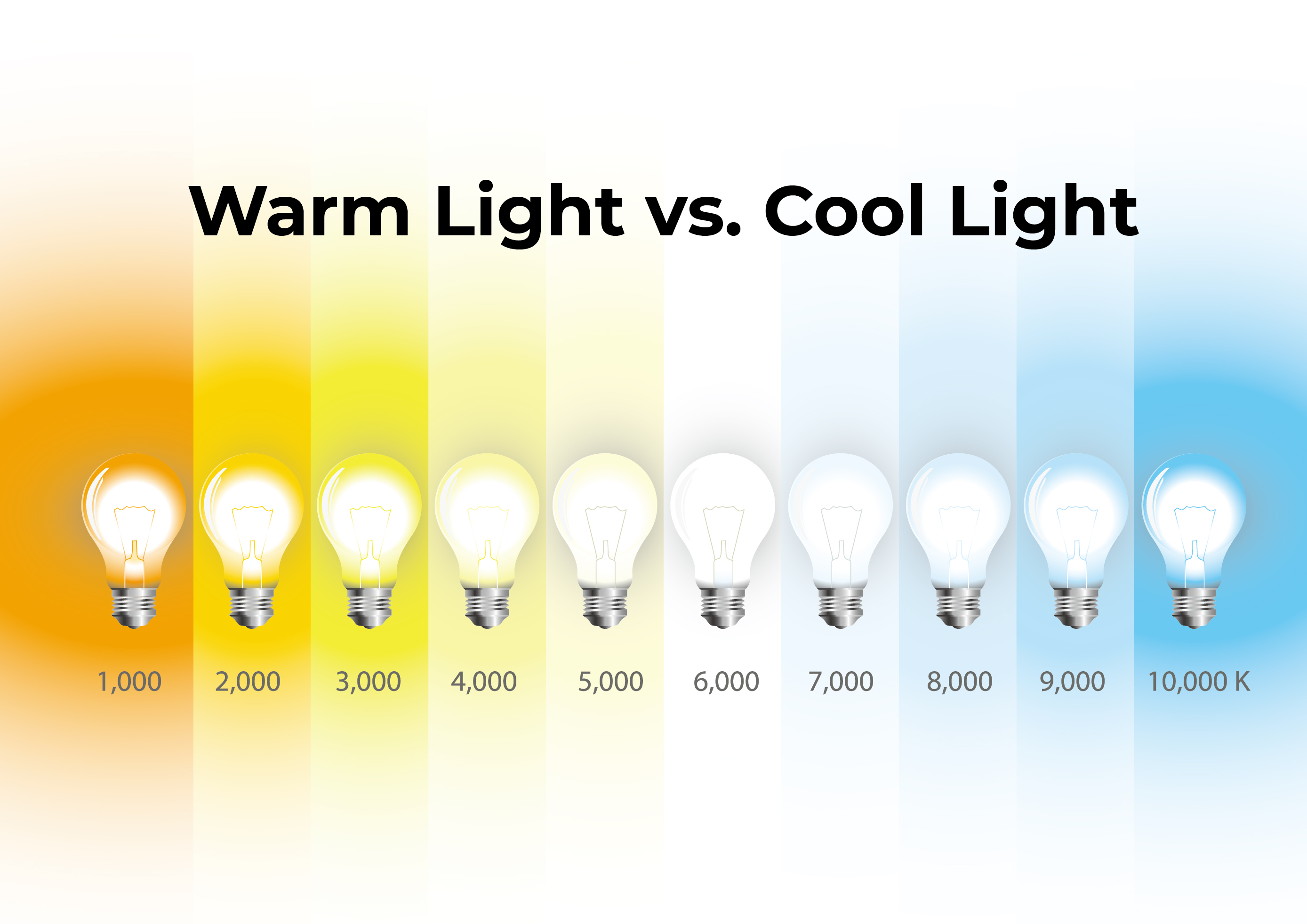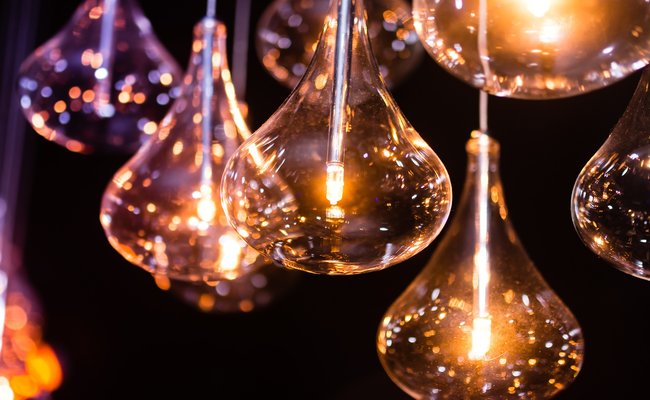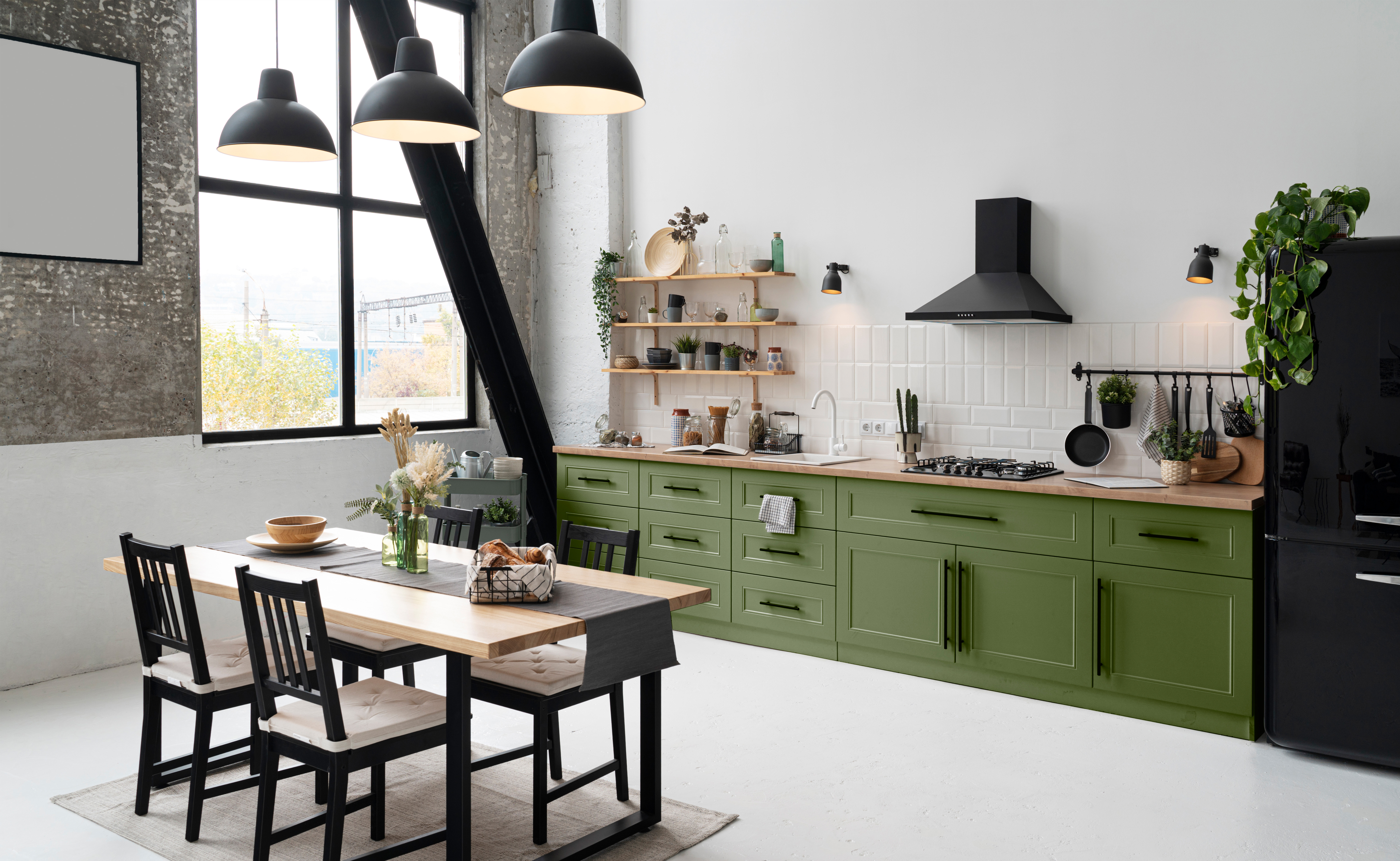Warm Light vs. Cool Light: Which Is Better?

Making the right choice between warm light and cool light can have a significant impact on the ambiance and functionality of a space. Both types of light have their distinct characteristics and ideal use cases.
Here's a comprehensive look at the differences between warm and cool light and when you might prefer one over the other.
The Basics of Color Temperature
Light color is typically described by its color temperature. The color temperature concept derives from the physical property of "black body" radiation - a theoretical construct in physics. As you heat a black body, it glows in colors that change as the temperature rises: first red, then yellow, and finally white. This chromatic shift is the crux of our color temperature perception in lighting.
Color temperature is measured in Kelvin (K) and ranges from low (red) to high (blue). Warm light differs from cool light essentially due to its Kelvin values.
What Is Warm Light?
Often likened to the comforting aura of a setting sun, warm light is characterized by a color temperature under 3000 Kelvin (K). Warm light gives off red, orange, or yellow hues, evoking a sense of coziness, tranquility, and relaxation.
Examples of warm light include candlelight, halogen lamps, and yellow LED lights.

Pros of Warm Light
Relaxing Ambiance: Warm light creates a cozy atmosphere in living rooms, dining areas, and bedrooms. It is also often used in outdoor lighting to provide a welcoming ambiance.
Reduced Eye Strain: Warm light tends to cause less strain on the eyes, making it easier to use for extended periods.
Better Sleep: Warm light can stimulate the production of melatonin, a hormone that regulates sleep, thereby fostering a healthier sleep cycle.
Aesthetics: Warm light can enhance the aesthetics of a space, adding an intimate, cozy feel. It's often preferred in settings where a homely, welcoming ambiance is desired.
Cons of Warm Light
Poor Color Rendering: Warm light may not render colors as accurately as cool light, making it less suitable for tasks that require color precision.
Limited Visibility: The subdued, cozy nature of warm light might not be ideal for performing detail-oriented tasks, such as reading small print or crafting.
Perceived Lack of Brightness: Due to its lower color temperature, warm light can often be perceived as dimmer than cool light, which might be unsuitable in some settings.
What Is Cool Light?
Cool light typically has a color temperature exceeding 4000 Kelvin (K). It is brighter and emanates a bluish-white glow reminiscent of a clear sky at noon or an overcast day.
Examples of cool light include white LED lights and neon signs.
Pros of Cool Light
Improved Concentration: The bright and sharp nature of cool light can enhance focus and productivity. It's often used in workplaces or study areas to stimulate alertness and mental clarity.
Enhanced Color Accuracy: Cool light generally provides better color rendering than warm light. This is particularly beneficial in spaces where color differentiation and precision are necessary.
Increased Visibility: The higher luminosity of cool light makes it suitable for detailed tasks, such as reading, writing, or crafting, where clear visibility is critical.
Mood Stimulation: Cool light can invigorate the mood and create an energetic, vibrant environment, ideal for active spaces like a workspace, a bustling kitchen, or a lively retail store.
Cons of Cool Light
Potential Eye Strain: Prolonged exposure to cool light can lead to eye strain, especially in individuals sensitive to brighter light.
Sleep Disruption: Exposure to cool light, especially in the evening, can interfere with the body's production of melatonin, a hormone that helps regulate sleep.
Impersonal Atmosphere: While it's excellent for focus and activity, cool light can sometimes create a cold or sterile feeling if not balanced with warmer tones.
Warm Light vs. Cool Light: What is the Difference?
The key difference between warm and cool light is their color temperature and appearance. Warm light has a color temperature below 3000 Kelvin (K) and contains reddish and yellow tones, while cool light has a color temperature above 4000 Kelvin (K) and has a bluish-white appearance.
Besides color temperature and visual impact, warm light and cool light can be compared from the following aspects:
Aesthetics and Interior Design
The choice between warm and cool light significantly influences the visual appeal of a space. Warm light often complements traditional or rustic decor, enhancing wooden furniture and earth tones. Conversely, cool light tends to accentuate modern or minimalist interiors, highlighting white and metallic surfaces.
Task Suitability
With its increased brightness, cool light is best used for task-oriented activities, such as reading, writing, crafting, or cooking, where high visibility is required. Warm, softer light is better suited for relaxing activities, such as watching TV or winding down before sleep.
Energy Efficiency
Regardless of color temperature, LED bulbs are known for their energy efficiency. However, cooler LED lights are typically slightly more energy-efficient than warmer ones. This is due to the physics of producing warmer light hues, which slightly reduces the energy efficacy.
Effect on Sleep
Both light types can impact our circadian rhythms, which regulate our sleep and waking cycles. Exposure to cool light in the evening can suppress melatonin production, potentially disrupting sleep patterns. Warm light, simulating dusk, is less likely to interfere with sleep and is often recommended for bedroom use.
Color Rendering Index (CRI)
Cool light generally has a higher CRI, which means it represents colors more accurately. This is particularly important in spaces like art studios, retail stores, or kitchens where color differentiation matters.
For your reference, here's a chart including the main differences between warm and cool light.
Best Light Color Recommended for Your Home
When it comes to illuminating your home, choosing the optimal light color isn't a one-size-fits-all scenario. Instead, it varies according to each room's purpose, decor, and desired ambiance. Both warm and cool light have their respective applications in home lighting design.
Living Room: This space is where families gather for relaxation and casual conversation, making it a hub of comfort and warmth. Warm light works better here, creating a soft, homely ambiance and enhancing the look of wooden furniture, draperies, and traditional decor. It creates a cozy, intimate environment perfect for unwinding, watching TV, or enjoying a laid-back gathering with friends.
Kitchen: Kitchens are often functional spaces where meal preparation takes place. The crispness of cool light serves well here, aiding in the completion of necessary tasks.

In many homes, however, the kitchen has evolved from mainly functional to a meeting spot for the occupants. In such cases, a mix of cool and warm light can be opted for, matching the versatility of the space.
Bedroom: As a sanctuary for rest, bedrooms benefit from the calming influence of warm light. Its softer, yellower tones can reduce the strain on the eyes before sleep and foster a peaceful atmosphere. Moreover, warm light has been found to stimulate the production of the sleep hormone and improve sleep quality.
Bathroom: Depending on the design, bathrooms can be versatile in their lighting needs. Cool light is excellent for grooming tasks, like applying makeup or shaving, due to its color accuracy. However, a bathroom meant for soaking in the tub might benefit from the relaxing mood set by warm light.
Home Office: Productivity and alertness are critical in a workspace, and cool light helps foster this. It improves focus and fits well with a sleek, modern office design.
Garden: Outdoor lighting primarily creates a safe and serene ambiance. The glow of warm light is ideal for this purpose, providing a welcoming atmosphere for evening gatherings, subtly highlighting landscaping features, and complementing the natural twilight hues at dusk.
To briefly summarize:
Where to use warm light: Spaces designed for relaxation, comfort, and socializing. These include the living room, bedroom, gardens, etc.
Where to use cool light: Areas where tasks require precision and focus. This includes kitchens, home offices, bathrooms, etc.
Bonus Tips: How to Choose the Best LED Light
Here are some insightful tips to ensure you select the best cool and warm LED light for your needs.
1. Determine the Room's Function
The room's function is critical in choosing a cool or a warm light LED. Warm light creates an inviting and relaxing atmosphere, making it suitable for living rooms and bedrooms. On the other hand, cool light provides bright and clear illumination, ideal for workspaces, kitchens, or bathrooms.
2. Pay Attention to the Color Rendering Index (CRI)
The CRI of a light source influences how accurately colors appear under it. For spaces where color accuracy matters, such as a kitchen or an artist's studio, consider LED lights with a higher CRI, preferably above 80.
3. Consider the Brightness (Lumens)
When it comes to LED lights, brightness is measured in lumens, not watts. Lumens measure the total amount of visible light from a light source. Therefore, when choosing LED lights, look at the lumen count to determine the light's brightness.
4. Check Energy Efficiency
LED lights are renowned for their energy efficiency, but some are more efficient than others. When selecting LED lights, look for those with an Energy Star rating. These products meet stringent performance standards and ensure energy efficiency.
5. Dimmability
Depending on the versatility you want with your lighting, dimmability can be a crucial factor. If you want the ability to adjust the light intensity in a room, ensure that the LED light you choose supports dimming.
6. Longevity and Warranty
A quality LED bulb can last many years, even with substantial use. Typically, a longer warranty period implies a more reliable product. Thus, when choosing your LED light, consider its longevity and the warranty offered.
7. Consider Smart Lighting Options
In our modern world, having a smart home is becoming more of a norm. Some LED lights offer smart features like remote control, scheduling, or even integration with your home assistant devices. If these features align with your lifestyle, consider choosing smart LED lights.
8. Be Mindful of Fixture Compatibility
Ensure the LED light bulb you choose is compatible with your existing light fixtures. Compatibility extends beyond just the base size. The shape and size of the bulb itself also matter to ensure it fits well and looks proportional in the fixture.
FAQs
Is Warm or Cool Light Better for the Eyes?
The ideal lighting for eye comfort isn't a simple case of warm versus cool light. It often depends on the task at hand and the individual's sensitivity. However, prolonged exposure to excessively bright cool light, especially at night, may cause eye strain for some people.
What Type of Light Is Best for Relaxing?
For relaxation, warm light is often recommended. The lower color temperatures create a cozy and serene atmosphere, perfect for unwinding after a long day or setting a calming mood.
Is Cool Light More Energy-Efficient than Warm Light?
Yes, cool light is slightly more energy-efficient than warm light. However, the energy efficiency of a light bulb depends on other factors like its type (LED, incandescent, compact fluorescent).
Why Does Warm Light Look Better?
Many people find warm light more visually appealing because it mimics the hue of natural evening light, creating a cozy and comforting environment. It casts softer shadows and is often more flattering to skin tones, contributing to its perception as "looking better."
Should I Have Warm or Cool Light at Night?
It depends on where you want to use it. Generally, warm light is recommended for nighttime use in the bedroom as it encourages relaxation and sleep. For outdoor nighttime use, you may be better off with cool, brighter lights that illuminate the surroundings better and improve security.
Conclusion
With warm light and cool light offering distinct atmospheres and functionalities, finding the perfect lighting solution adds a unique dynamic to your spaces. Warm light provides a welcoming, cozy ambiance, while cool light inspires clarity and focus. Your ultimate choice should harmonize with the room's purpose and your taste.
Gladly, your decision doesn't have to be unilateral. Mixing and matching different lighting options can lead to a more tailored environment.
What type of lighting do you prefer? How has switching to a particular color temperature improved your space? If you have any ideas or questions, remember to leave a comment below.
Search
Subscribe for the Latest Updates
Security insights & offers right into your inbox
